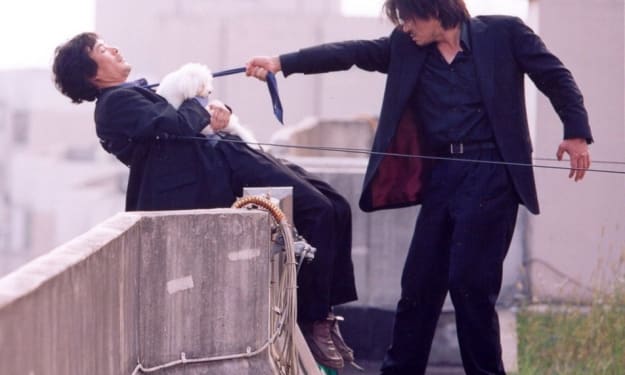The Importance of Film Within Korean Society
Part One - Defining Korean Cinema

In order to define Korean cinema as it is now, it is important to place it into some sort of context given the country's century of oppression, division, and warfare. Historically, Korean cinema seems to have been non-existent, with nothing surviving from the era of silent films (1926-1935), and according to Adriano Apra (as cited by Rist, 1998, online) only three films have survived from before 1946 and these are not considered Korean but Japanese due to the World War II occupational force at the time. It was not until the 1960s that a significant film production could be seen in Korea’s cinema industry. Now Korea is experiencing a "new wave" of film making and cinema fanaticism, which in the Korean language is called "Hal-u" and has been likened to France in the 1960s, Hollywood in the 1970s and Hong Kong in the 1980s in their leap into world cinema. The very fact that the people of Korea have their own term for this phenomenon and are therefore recognising its existence as a part of their society suggests that it has a firm place in their everyday lives. To give an idea of just how popular cinema in Korea is becoming, it has been noted that in the south the number of cinema screens has almost tripled in the last eight years and the attendance is still steadily rising all the time. With these successes within Korea itself, a further key to its expanding popularity is tapping into the international sales. Korea is now exporting at the very least ten times as many films compared with the early 90s. In an interview for Subway Cinema, Korean film director Kim Jee-Woon stated, "Looking at the Korean film industry, they are dealing with a variety of subjects and different genres, and that’s one of the strengths of the current Korean film market" (Kim Jee-Woon 2001, online). He is saying that unlike places such as Hong Kong, where their films are primarily martial arts orientated, and therefore introduced to the rest of the world as such, Korean films have a wider base. This I have learnt is largely due to the wide selection of backgrounds and origins of the directors, as mentioned by Jonathan Ross in his recent documentary series on Asian cinema, Asian Invasion shown on BBC4, January 2006. I will go into greater detail of these varied backgrounds and the reasons for them in the social political context chapter. This fully encompassing genre industry means that so far, Korean films have yet to be classified by the rest of the world, like Hong Kong films have been, and to an extent Japanese films have been classified as that of mainly the horror genre thanks largely to the many Hollywood remakes such as The Ring and Dark Water.
In taking a look at the beginnings of the popularity of Korean cinema and what caused this phenomenon, its origins would seem to come from some of the films produced at the time. One of the films that started this new rise in successful Korean films is Nowhere to Hide (1999). Directed by Lee Myung-Se, its Korean name however translates directly as "I Don’t Give a Shit About Anything" which is a statement from the director in itself, that is unfortunately lost in the translation of the film and the attempts to have it fit with the western film approach. And although no real similarities can be drawn between this film and the highly successful Park Chan-Wook films which came about later, it was as successful in its own right for its time. Park Chan-Wooks films, such as Old Boy (2003) make deep and meaningful philosophical statements, whilst Nowhere to Hide (1999) has probably best been summed up as an action thriller by various film critics and reviewers such as Joan Dupont who described the film as "a thriller that looks like no other movie, inside or outside Korea." (Dupont 1999). This was the film that set Lee Myung-Se's career as a director in motion as he has been called more of an artist because of his creative use of visual language and style. Lee Myung-Se’s roots in artistic matters come from his graduation from Seoul Institute of Arts. Dupont goes on to explain the directors film techniques: "He approaches cinema as an investigation into movement and light, using a palette of saturated colors; images melt into each other. He warps time, space and narrative." Myung-Se left his home country to try directing in Hollywood shortly after this film's success, but unfortunately had no luck there and so has now returned to South Korea. The other noteworthy film that triggered this wave of Korean cinema popularity is Attack the Gas Station (1999) directed by Kim Sang-Jin and its overall style and atmosphere can best be likened to that of Guy Richie, John Carpenter, and Quentin Taratino’s earlier works. The film is about a group of teenagers who rob and decide to take over a gas station and the mischief they cause while in charge. All the antics the teenagers get up to are meant to emulate their own misgivings for society. For example, at one point, they stage fist fights between the employees of the gas station and street gang members. Although this film is visually less stylised compared with Nowhere to Hide (1999), it was still a success within Korea and also became a world release later on. Both these films proved innovative to the cinema industry and the films that followed, thus leading Korean films and audiences into this nouvelle vague of recognition.
Another sign of how important film is in Korean society is how seriously it is taken by those involved directly, such as the actors and directors. A good example of this is a film called Spring, Summer, Autumn, Winter… and Spring (2003) directed by Kim Ki-Duk. Kim is known for producing low budget, but significant and successful movies despite his strange methods of creating them (which I will go into detail about in the social and political context chapter later). The dedication that went into making this film by all those involved is rarely, if ever, seen in the west. This film was shot over the course of a full year and then some to fit the setting in with the changing of the seasons. Through this movie, Kim was attempting to liken the different and ever changing, seasons to the seasons of life itself. This meant that the cast and crew had to put aside what they were doing in their daily lives and be ready to start filming again at anytime Kim called them back up, and this went on for over a year. These people gave an exceptional amount to a low budget film that didn’t even have a script. This is not the only example of this devotion on the part of those working on the films. Park Chan-Wook seems to take a certain pride that his actors suffer on behalf of his films. He mentions in an interview with Ceri Thomas for Total Film Magazine, "All the Korean actors know when they work with me they’re going to be tortured." (Park 2006).






Comments
There are no comments for this story
Be the first to respond and start the conversation.